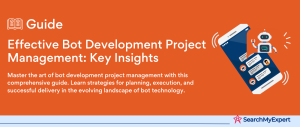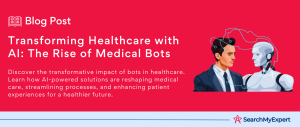Bots in Education and Training: Revolutionizing Learning Environments
Embracing the Future: Bots in Modern Education
The world of technology is in constant evolution, bringing forth innovations that reshape our daily lives. Among these innovations, bots have emerged as a standout, especially in their application across diverse fields. These sophisticated programs, designed to automate tasks and simulate human interaction, are increasingly becoming integral components of various industries.
Transformative Tech in Learning: The Rise of Educational Bots
In the realm of education and training, bots are swiftly making their mark. They represent a transformative technology that is redefining traditional teaching and learning methods. Their integration into educational settings is not just a fleeting trend; it’s a forward-looking movement that aligns with the dynamic nature of the digital age.
Balancing Act: Benefits and Challenges
The potential benefits of utilizing bots in education and training are manifold. They offer personalized learning experiences, instant feedback, and the ability to engage students in innovative ways. However, this technological integration is not without its challenges. Concerns such as ensuring effective learning outcomes, addressing privacy issues, and overcoming technological limitations are pivotal in the successful implementation of bots in educational contexts.
Types of Bots in Education and Training: Diverse Roles, Transformative Impacts
In the rapidly evolving landscape of education and training, bots have carved out significant roles, each distinct in its purpose and functionality. These digital assistants, leveraging artificial intelligence and machine learning, are not just tools but catalysts for change in the way we approach learning and administration in educational settings.
Virtual Tutors: Tailored Learning at Your Fingertips
Virtual tutors are at the forefront of personalized education. These bots adapt to individual learning styles and paces, offering tailored questioning and immediate feedback. Their ability to provide customized learning experiences makes them invaluable in fostering a deeper understanding of subjects.
Learning Companions: Making Education Fun and Engaging
Learning companions take the concept of gamified learning to new heights. They offer motivational support and interactive practice exercises, turning mundane study sessions into engaging and fun experiences. Their role in keeping students motivated and focused cannot be overstated.
Skill Trainers: Mastering Skills through Simulation
Skill trainers utilize simulation-based training to provide hands-on experience in a safe, controlled environment. They offer procedural guidance and correct errors in real time, making them ideal for training in specialized fields like medicine, engineering, and aviation.
Administrative Assistants: Streamlining Educational Administration
Administrative bots are revolutionizing the way educational institutions manage their operations. From handling course registrations to answering FAQs and scheduling appointments, these bots significantly reduce administrative burdens and improve efficiency.
Assessment Tools: Redefining Evaluation
Assessment tools are changing the face of testing and evaluation. These bots administer automated quizzes and tests, provide personalized feedback, and track progress over time. They offer an objective and efficient way to measure learning outcomes, benefiting both educators and learners.
Benefits of Using Bots in Education and Training: Enhancing Learning Experiences
The integration of bots in education and training has brought about a plethora of benefits that are transforming the learning landscape. These AI-powered tools are not just about embracing new technology; they are about reimagining the entire educational experience.
Unmatched Accessibility and Flexibility
Bots break down traditional barriers to education. They enable learners to engage with educational content anytime and anywhere, offering unparalleled flexibility. This “learn at your own pace” approach democratizes education, making it accessible to a wider audience regardless of geographical or time constraints.
Personalized Learning Journeys
One of the standout features of educational bots is their ability to adapt to the individual learning needs and styles of students. This personalized approach ensures that each learner receives the attention and resources that are best suited to their learning curve, leading to more effective and satisfying educational experiences.
Round-the-Clock Support
Bots offer 24/7 support, providing immediate help and feedback, a feature particularly crucial for learners in different time zones or those balancing education with other commitments. This constant availability ensures that learners have the assistance they need whenever they need it.
Engaging and Interactive Learning Methods
Through gamified experiences and simulations, bots make learning more engaging and interactive. This approach not only makes education fun but also enhances retention and understanding by providing practical, hands-on experiences in a controlled environment.
Easing Educator Workloads
Bots significantly reduce the workload on educators by automating repetitive tasks such as grading, scheduling, and responding to frequently asked questions. This automation allows educators to focus more on providing personalized interaction and addressing complex learning needs.
Challenges and Considerations in Implementing Bots in Education and Training: Navigating the Complexities
While the integration of bots in education and training offers numerous advantages, it’s essential to recognize and address the challenges and considerations that accompany their deployment. Understanding these complexities is crucial for maximizing the benefits while minimizing potential drawbacks.
Navigating Limited Understanding and Adaptability
One of the primary challenges with educational bots is their limited understanding and adaptability, especially when dealing with complex questions or nuanced concepts. While AI and machine learning have advanced significantly, bots may still struggle to grasp the depth and context of certain subjects, potentially leading to misunderstandings or incomplete learning experiences.
Addressing Technical Dependence and Equity Issues
The reliance on technology for educational bots raises concerns about equity and access. Not all students may have equal access to the necessary technology or reliable internet, creating a digital divide. This issue underscores the need for inclusive strategies that ensure all learners can benefit from these advancements.
Balancing Over-Reliance on Bots
While bots can enhance learning, over-reliance on them could undermine the importance of human interaction and social learning, which are vital for holistic development. It’s crucial to find a balance where bots supplement rather than replace human educators, preserving the human element in education.
Ensuring Ethical Practices
Ethical considerations, including data privacy, transparency, and algorithmic bias, are paramount when implementing bots in educational settings. Protecting student data and ensuring that algorithms are unbiased and transparent are essential to maintain trust and efficacy in these systems.
Case Studies and Examples: Bots Transforming Education in Real-Life
Virtual Tutoring in Higher Education
- Example: Georgia Tech’s “Jill Watson”
- Challenge Addressed: Managing a large volume of student inquiries in an online class.
- Outcome: “Jill Watson”, a bot built on IBM’s Watson platform, was integrated into an online master’s course to act as a teaching assistant. It successfully handled routine student queries, freeing up human TAs for more complex issues. The bot’s accuracy and speed in responding to students improved engagement and efficiency in the course.
Language Learning Companion
- Example:
Duolingo’s Chatbots - Challenge Addressed:
Providing a safe, interactive environment for practicing language skills. - Outcome:
Duolingo, a popular language learning app, introduced chatbots to allow learners to practice conversations in a stress-free setting. These bots offer corrections and guidance, enhancing language learning through practical application and immediate feedback.
Skill Training in Medical Education
- Example:
Medical Simulation Bots - Challenge Addressed:
Training medical students in diagnosis and patient interaction without risk. - Outcome:
Medical training institutions have started using bots for simulated patient interactions. These bots can replicate symptoms and responses, providing a realistic and risk-free environment for students to learn and practice their diagnostic skills.
Administrative Support in Schools
- Example: AdmitHub’s College Advising Bot
- Challenge Addressed:
Streamlining administrative tasks and student support services. - Outcome:
AdmitHub developed a bot that assists students with college applications and financial aid questions. By providing instant responses to common queries, the bot significantly improved the efficiency of administrative processes and enhanced student satisfaction.
Automated Assessment in Online Learning
- Example: Coursera’s Automated Essay Grading
- Challenge Addressed: Scaling grading efforts for massive open online courses (MOOCs).
- Outcome: Coursera implemented bots for automated essay grading, enabling them to handle a large number of submissions. This approach ensures timely feedback to students and reduces the grading workload for instructors.
These case studies demonstrate the diverse applications and benefits of bots in educational settings. They address key challenges and significantly improve outcomes, showcasing the potential of bots to revolutionize learning experiences.
The Future of Bots in Education and Training: Embracing Tomorrow’s Innovations
The horizon of educational technology is ever-expanding, and bots are poised to play a pivotal role in this dynamic future. As we look ahead, the advancements in bot technology and their potential impact on education and training are both exciting and transformative.
Advanced AI and Machine Learning
- Next-Gen Capabilities:
Future bots will exhibit more advanced AI and machine learning capabilities, leading to greater understanding, adaptability, and more nuanced interactions. - Impact on Education: This advancement will enable bots to handle complex educational tasks, provide more sophisticated support, and offer deeply personalized learning experiences.
Immersive Virtual Learning Environments
- Virtual Realms:
The integration of bots in immersive virtual environments, like augmented and virtual reality (AR/VR), is an emerging trend. - Educational Transformation:
Such environments will offer students experiential learning opportunities, making education more engaging and impactful, especially in fields requiring hands-on experience.
AI-Powered Personalized Learning
- Customized Education: Future bots will harness AI to offer highly personalized learning paths based on individual student data, learning styles, and progress.
- Enhanced Learning Outcomes: This personalization will lead to more effective learning, with content and pacing tailored to each learner’s unique needs.
Collaborative Bots and Human Educators
- Synergistic Relationships:
The collaboration between bots and human educators will become more seamless, enhancing the educational ecosystem. - Balanced Approach: This synergy will ensure that the unique strengths of both AI and human instructors are leveraged for optimal educational outcomes.
Ethical AI in Education
- Focus on Ethical AI:
As bot technology evolves, there will be a heightened focus on developing ethical AI, addressing concerns around data privacy, bias, and transparency. - Responsible Implementation: Ensuring ethical practices in AI will be crucial for maintaining trust and effectiveness in educational bots.
The future of bots in education and training is not just about technological advancement but about redefining the learning experience itself. It promises a world where education is more accessible, personalized, immersive, and effectively blended with a human touch.
Embracing the Future of Bots in Education with Responsibility and Vision
As we navigate the ever-evolving landscape of technology in education, the role of bots emerges as both promising and challenging. This journey through the world of educational bots has illuminated their potential to revolutionize learning, as well as the considerations necessary for their successful integration.
Summarizing the Bot Revolution in Education
- Personalized Learning and Accessibility:
Bots offer unparalleled opportunities for personalized and accessible education, catering to diverse learning styles and needs. - 24/7 Support and Interactive Learning:
They provide round-the-clock assistance and make learning more engaging through interactive and gamified experiences. - Efficiency in Administration and Assessment:
Bots significantly ease the workload of educators by automating administrative tasks and providing efficient assessment tools.
Acknowledging Challenges and Ethical Considerations
- Overcoming Technical Limitations: Despite their advancements, bots still face challenges in understanding complex concepts and ensuring equitable access.
- Maintaining the Human Element:
It’s crucial to balance the use of bots with the irreplaceable value of human interaction and social learning. - Upholding Ethical Standards: Ensuring data privacy, transparency, and addressing algorithmic biases are essential for maintaining trust and effectiveness.
A Call to Action: Responsible Development and Integration
- Continued Research and Development:
There’s a pressing need for ongoing research to enhance the capabilities of bots while addressing their limitations. - Thoughtful and Ethical Integration: As we integrate bots into educational practices, it’s vital to do so thoughtfully, ensuring that they complement rather than replace human educators and traditional learning methods.
- Collaborative Efforts:
Stakeholders including educators, technologists, and policymakers must collaborate to ensure the responsible development and implementation of these technologies.
Conclusion
The integration of bots in education and training presents a horizon brimming with opportunities. By embracing these advancements responsibly and ethically, we can enhance learning experiences while preparing for a future where technology and education are seamlessly intertwined.
Transform your customer service with leading Bot Development Service Companies.
Table of Contents
Toggle






